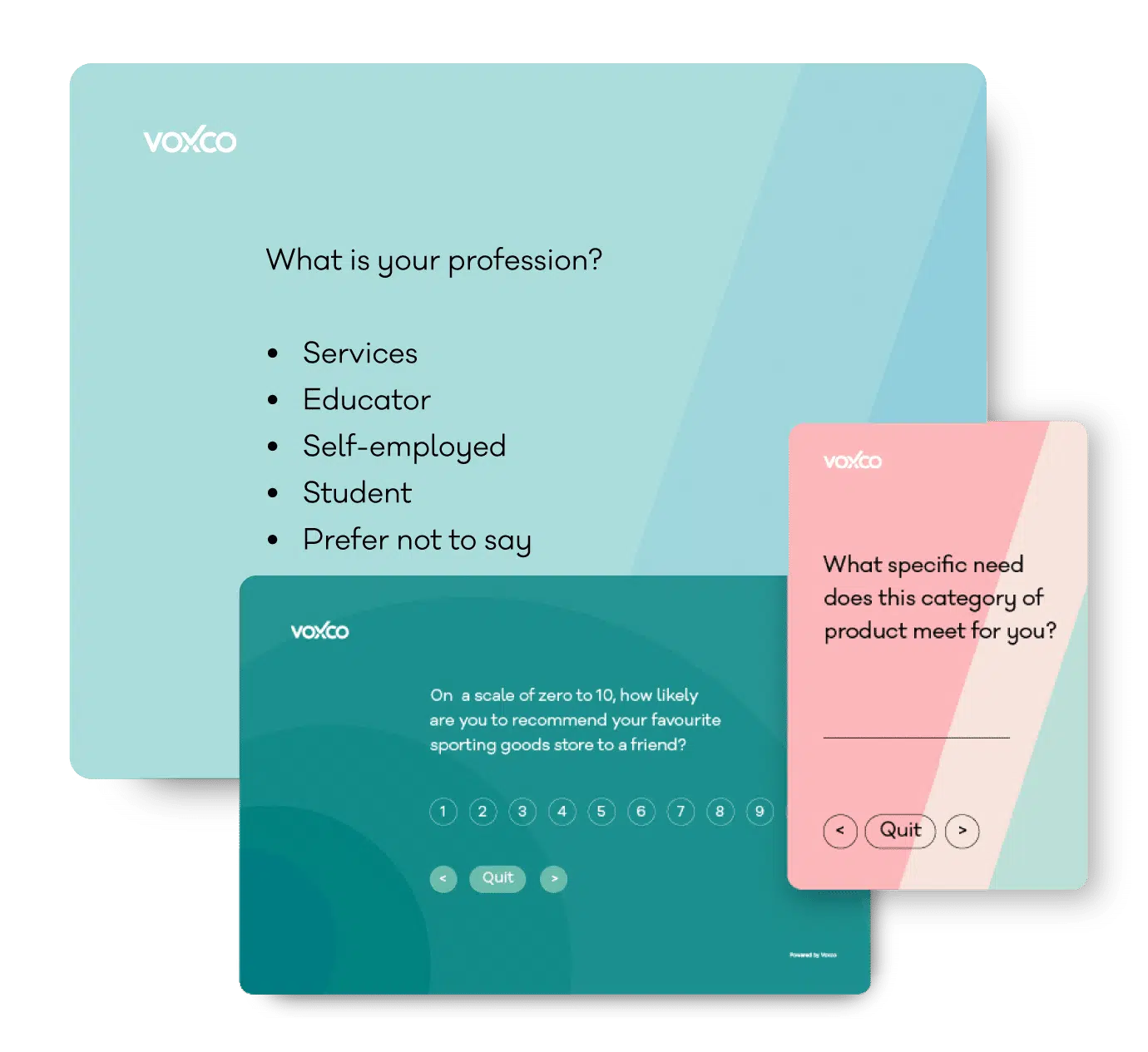
psychographic segmentation
Conducting research studies can be intense! Surveys, analytics, data verification, and monitoring. One of the most rewarding parts of research is when you get to showcase your survey results to your stakeholders.

Find the best survey software for you!
(Along with a checklist to compare platforms)
Take a peek at our powerful survey features to design surveys that scale discoveries.
Explore Voxco
Need to map Voxco’s features & offerings? We can help!
Find the best customer experience platform
Uncover customer pain points, analyze feedback and run successful CX programs with the best CX platform for your team.

We’ve been avid users of the Voxco platform now for over 20 years. It gives us the flexibility to routinely enhance our survey toolkit and provides our clients with a more robust dataset and story to tell their clients.
Steve Male
VP Innovation & Strategic Partnerships, The Logit Group
Explore Regional Offices

Find the best survey software for you!
(Along with a checklist to compare platforms)
Take a peek at our powerful survey features to design surveys that scale discoveries.
Explore Voxco
Need to map Voxco’s features & offerings? We can help!
Find the best customer experience platform
Uncover customer pain points, analyze feedback and run successful CX programs with the best CX platform for your team.

We’ve been avid users of the Voxco platform now for over 20 years. It gives us the flexibility to routinely enhance our survey toolkit and provides our clients with a more robust dataset and story to tell their clients.
Steve Male
VP Innovation & Strategic Partnerships, The Logit Group
Explore Regional Offices

Find the best survey software for you!
(Along with a checklist to compare platforms)
Take a peek at our powerful survey features to design surveys that scale discoveries.
Explore Voxco
Need to map Voxco’s features & offerings? We can help!
Find the best customer experience platform
Uncover customer pain points, analyze feedback and run successful CX programs with the best CX platform for your team.

We’ve been avid users of the Voxco platform now for over 20 years. It gives us the flexibility to routinely enhance our survey toolkit and provides our clients with a more robust dataset and story to tell their clients.
Steve Male
VP Innovation & Strategic Partnerships, The Logit Group
Explore Regional Offices
In today’s dynamic and competitive business landscape, staying ahead of the curve is not just an advantage—it’s a necessity. Businesses need to constantly evolve and adapt to meet the changing demands and preferences of their target markets. This is where Market Intelligence Research comes into play. It equips businesses with the insights and knowledge needed to make informed decisions, drive innovation, and ultimately, gain a competitive edge. In this comprehensive guide, we will delve into the world of Market Intelligence Research, covering its definition, types, methodologies, advantages, and its pivotal importance.
Market intelligence is simply data or information gathered from the market in which a business operates to make informed business decisions. This data allows businesses to gain insights into current market trends, customer behaviors, preferences, emergence of new technologies, pricing strategies, and other supporting information that could guide business decisions.
For example: A car company’s growth has been stagnant for quite some time. The senior management wants to understand the reasons for this state and identify areas where the company can improve to prevent such hindrances in the future. In such a case, the company can gather market intelligence and seek answers to questions such as: Has the growth of all the other companies in the market been affected in the same manner? If not, what are they doing differently? Why aren’t customers interested in buying cars? How do customers rate the company in terms of service, pricing, design, features, and appeal? Getting answers to such questions can allow the company to channel its resources towards its weaknesses and rise from the current situation they are in.
Market Intelligence comes in various forms, each offering unique perspectives and insights crucial for a business to thrive. Here’s a brief overview of the primary types:
Understanding the competitive landscape is vital. This type focuses on gathering information about competitors, their strategies, strengths, weaknesses, and market positioning.
Competitor Analysis: Thorough analysis of competitors’ products, pricing strategies, marketing tactics, and market share.
SWOT Analysis: Evaluating competitors based on their strengths, weaknesses, opportunities, and threats.
Customers are the heart of any business. Customer intelligence involves analyzing customer behaviors, preferences, feedback, and purchasing patterns to enhance products and services.
Surveys and Questionnaires: Conducting surveys to gather consumer opinions and preferences.
Social Media Monitoring: Analyzing consumer sentiment and feedback on social media platforms.
For a successful product strategy, understanding your own product’s performance and its perception in the market is essential. This type focuses on gathering insights about your own offerings.
Product Reviews Analysis: Studying customer reviews and ratings to identify strengths and weaknesses of the product.
Usage Analysis: Analyzing customer usage patterns and identifying features that are most valued.
Market research involves studying market dynamics, trends, demographics, and consumer behavior. It provides an overall view of the market you operate in or plan to enter.
Data Analytics: Utilizing advanced analytics tools to identify patterns and trends in large sets of data.
Industry Reports: Accessing and analyzing reports published by industry associations and market research firms.
Knowing about your suppliers, their capabilities, reliability, and market standing is crucial for a streamlined supply chain and cost-effective operations.
Supplier Assessment: Evaluating suppliers based on their performance, reliability, and quality of products/services.
Demand Forecasting: Utilizing data and trends to predict future demand and plan the supply chain accordingly.
Markets operate within a framework of regulations. This type focuses on understanding the legal and regulatory environment affecting the industry, ensuring compliance and risk management.
Legal Analysis: Studying laws and regulations relevant to the industry and assessing their impact on business operations.
Government Publications: Keeping track of updates and publications from regulatory authorities.
In today’s tech-driven world, being aware of emerging technologies and innovations is critical. Technology intelligence involves tracking advancements that could impact your industry.
Patent Analysis: Studying patents related to specific technologies to identify trends and innovation areas.
Technology News Monitoring: Keeping track of technology-related news, blogs, and research papers.
Market intelligence is vital, encompassing external forces that impact a business. It’s crucial to understand these factors as they influence operations significantly. Good market intelligence complements internal awareness, aiding decisions like product launches, ads, pricing, offers, and more. This is key for both major market players and emerging brands, enabling effective market analysis for informed strategies.
The benefits of Market Intelligence are far-reaching and play a vital role in shaping a successful business strategy. Here are some key advantages:
Market Intelligence provides businesses with valuable insights, enabling them to make data-driven decisions that align with market trends and consumer demands.
Understanding competitors’ strategies and market positioning allows businesses to differentiate themselves and stay ahead in the competitive landscape.
By identifying potential risks and market uncertainties, businesses can proactively plan strategies to mitigate these risks and navigate challenges effectively.
Market Intelligence helps in optimizing resource allocation by focusing efforts and investments on areas with the highest market potential and ROI.
Business intelligence is an inward approach to gathering information. Organizations use business intelligence to measure their progress toward objectives and update themselves on sales, revenue, employee performance, departmental contributions, etc. This helps them assess how their business is performing and identify weak points for improvement to increase business efficiency.
On the other hand, market intelligence is an outward approach to data collection that gathers information on an organization’s functioning from a macro perspective by analyzing trends and practices prevalent in the industry. This makes companies aware of competition, product preferences, and updated technology, which act as additional information for business decision-making.
Companies have a range of tools at their disposal for collecting valuable market intelligence. These tools vary in terms of ease of use, cost-effectiveness, and the depth of insights they can provide. Let’s explore some effective tools used for gathering market intelligence:
Conducting surveys online, in person, or via telephone is a fundamental method to gather data and opinions from a diverse audience. This allows for broad data collection without geographical constraints, enhancing accuracy.
Designing a Questionnaire: Crafting a well-structured questionnaire is crucial. Utilize online software with customizable features to enhance respondent engagement and improve response rates.
Distribution Strategy: Employ various channels such as email, website pop-ups, social media, and SMS invites to enhance accessibility and boost response rates. Real-time monitoring helps evaluate efficiency.
Compilation of Results: Utilize statistical and data analysis methods to derive meaningful insights. Summarize key findings for informed decision-making.
Personal interviews are a powerful method to delve deeply into aspects crucial for understanding market dynamics. They provide a direct line to individual perspectives on features, pricing, packaging, usage habits, and post-sales experiences. This approach offers a personalized touch, enabling researchers to comprehend respondents’ mindsets and gain valuable insights. However, it’s important to note that personal interviews have downsides; they are resource-intensive and time-consuming. The process may also inadvertently introduce sampling bias due to the limited number of respondents representing the broader target population.
Focus groups are carefully selected clusters of individuals, purposefully chosen to deliberate on the researcher’s queries. Moderators present scenarios and arguments, prompting respondents to express their viewpoints. These discussions shed light on customer behavior. Leveraging online platforms like Zoom for these discussions enhances accessibility and allows for polls, broadening the reach. For instance, a brand studying household buying habits in focus groups might include working individuals, teenagers, elders, and housewives. Their purchasing decisions, influenced by factors like budget and preferences, aid brands in tailoring their offerings to specific markets.
Sample sales are a tool for brands to gauge market acceptance before a product launch. Placing these products at select outlets allows for analysis of customer behavior. Observing customer queries before purchase provides valuable insights into how customers evaluate the product. For instance, Adidas and Costco leverage sample sales to enhance customer loyalty and boost short-term sales. Customers often end up purchasing more than intended or trying new products, leading to increased sales. Moreover, this strategy helps in testing the market’s response and refining the product if needed.
Data analysis is a pivotal step in market intelligence. It involves examining and summarizing collected data to aid understanding. The insights gained are crucial for stakeholders and senior management to make informed decisions. Utilizing advanced analytical tools like regression, factor analysis, and hypothesis testing, analysts compile and interpret the research data. Different tools are chosen based on data types – descriptive, quantitative, qualitative, parametrical, non-parametrical, etc. The results are visually presented using scatter plots, bar diagrams, pie charts, and more, enhancing comprehension and decision-making.
In conclusion, Market Intelligence Research is not just an additional step in business operations—it’s a strategic necessity. It equips businesses with the knowledge they need to make informed decisions, gain a competitive edge, and drive growth. To thrive in today’s competitive business environment, integrating Market Intelligence into your business strategy is no longer an option—it’s a fundamental requirement.
Ready to unlock your business potential with Market Intelligence? Start your journey today with Voxco and stay ahead of the curve!

Conducting research studies can be intense! Surveys, analytics, data verification, and monitoring. One of the most rewarding parts of research is when you get to showcase your survey results to your stakeholders.

Top 12 Pulse Survey Tools: Boost Employee Engagement SHARE THE ARTICLE ON Table of Contents Understanding your employee experience and satisfaction has become more harder,

Improve Customer Experience with Voice of Customers See what question types are possible with a sample survey! Try a Sample Survey Table of Contents Voice

An Exhaustive Guide to Different Types of Survey Research Techniques SHARE THE ARTICLE ON Table of Contents In a modern world, where companies run totally

A Complete Guide To Brand Identity SHARE THE ARTICLE ON Table of Contents Are you familiar with Nike? McDonald’s? Individuals all around the world know

How to enhance customer experience in retail SHARE THE ARTICLE ON Table of Contents What is customer experience? According to Wikipedia, customer experienced is defined
We use cookies in our website to give you the best browsing experience and to tailor advertising. By continuing to use our website, you give us consent to the use of cookies. Read More
| Name | Domain | Purpose | Expiry | Type |
|---|---|---|---|---|
| hubspotutk | www.voxco.com | HubSpot functional cookie. | 1 year | HTTP |
| lhc_dir_locale | amplifyreach.com | --- | 52 years | --- |
| lhc_dirclass | amplifyreach.com | --- | 52 years | --- |
| Name | Domain | Purpose | Expiry | Type |
|---|---|---|---|---|
| _fbp | www.voxco.com | Facebook Pixel advertising first-party cookie | 3 months | HTTP |
| __hstc | www.voxco.com | Hubspot marketing platform cookie. | 1 year | HTTP |
| __hssrc | www.voxco.com | Hubspot marketing platform cookie. | 52 years | HTTP |
| __hssc | www.voxco.com | Hubspot marketing platform cookie. | Session | HTTP |
| Name | Domain | Purpose | Expiry | Type |
|---|---|---|---|---|
| _gid | www.voxco.com | Google Universal Analytics short-time unique user tracking identifier. | 1 days | HTTP |
| MUID | bing.com | Microsoft User Identifier tracking cookie used by Bing Ads. | 1 year | HTTP |
| MR | bat.bing.com | Microsoft User Identifier tracking cookie used by Bing Ads. | 7 days | HTTP |
| IDE | doubleclick.net | Google advertising cookie used for user tracking and ad targeting purposes. | 2 years | HTTP |
| _vwo_uuid_v2 | www.voxco.com | Generic Visual Website Optimizer (VWO) user tracking cookie. | 1 year | HTTP |
| _vis_opt_s | www.voxco.com | Generic Visual Website Optimizer (VWO) user tracking cookie that detects if the user is new or returning to a particular campaign. | 3 months | HTTP |
| _vis_opt_test_cookie | www.voxco.com | A session (temporary) cookie used by Generic Visual Website Optimizer (VWO) to detect if the cookies are enabled on the browser of the user or not. | 52 years | HTTP |
| _ga | www.voxco.com | Google Universal Analytics long-time unique user tracking identifier. | 2 years | HTTP |
| _uetsid | www.voxco.com | Microsoft Bing Ads Universal Event Tracking (UET) tracking cookie. | 1 days | HTTP |
| vuid | vimeo.com | Vimeo tracking cookie | 2 years | HTTP |
| Name | Domain | Purpose | Expiry | Type |
|---|---|---|---|---|
| __cf_bm | hubspot.com | Generic CloudFlare functional cookie. | Session | HTTP |
| Name | Domain | Purpose | Expiry | Type |
|---|---|---|---|---|
| _gcl_au | www.voxco.com | --- | 3 months | --- |
| _gat_gtag_UA_3262734_1 | www.voxco.com | --- | Session | --- |
| _clck | www.voxco.com | --- | 1 year | --- |
| _ga_HNFQQ528PZ | www.voxco.com | --- | 2 years | --- |
| _clsk | www.voxco.com | --- | 1 days | --- |
| visitor_id18452 | pardot.com | --- | 10 years | --- |
| visitor_id18452-hash | pardot.com | --- | 10 years | --- |
| lpv18452 | pi.pardot.com | --- | Session | --- |
| lhc_per | www.voxco.com | --- | 6 months | --- |
| _uetvid | www.voxco.com | --- | 1 year | --- |